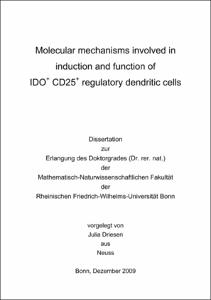Driesen, Julia: Molecular mechanisms involved in induction and function of IDO+ CD25+ regulatory dendritic cells. - Bonn, 2010. - Dissertation, Rheinische Friedrich-Wilhelms-Universität Bonn.
Online-Ausgabe in bonndoc: https://nbn-resolving.org/urn:nbn:de:hbz:5N-22180
Online-Ausgabe in bonndoc: https://nbn-resolving.org/urn:nbn:de:hbz:5N-22180
@phdthesis{handle:20.500.11811/4620,
urn: https://nbn-resolving.org/urn:nbn:de:hbz:5N-22180,
author = {{Julia Driesen}},
title = {Molecular mechanisms involved in induction and function of IDO+ CD25+ regulatory dendritic cells},
school = {Rheinische Friedrich-Wilhelms-Universität Bonn},
year = 2010,
month = jul,
note = {The main focus of this study was the characterization of the molecular mechanisms that are involved in the induction and function of regulatory dendritic cells (DCreg) which can be found in the environment of different tumors as well as in chronic infections. It was shown that co-expression of the tryptophan-catabolizing enzyme indoleamine-2,3-dioxygenase (IDO) and the α-chain of the IL-2 receptor (CD25) is one of the major hallmarks of DCreg, induced either by treatment with the tumor-derived factor PGE2 in combination with the maturation stimulus TNF or by infection with the Gram-positive bacteria Listeria monocytogenes.
Induction of IDO in DCreg is functional and leads to the deprivation of the essential amino acid tryptophan as well as an accumulation of its toxic metabolites, namely kynurenine. CD25 is also secreted in a soluble form (soluble CD25) and acts as a IL-2 scavenger, resulting in reduced amounts of accessible IL-2 for T cells. It was demonstrated that IDO+ CD25+ DCreg are able to suppress T-cell proliferation and that this inhibition is dependent on the effects of a variety of inhibitory molecules including IDO, CD25, IL-10 and COX-2 which act in concert to mediate the suppressive function of DCreg . Only the simultaneous blockade of all these inhibitory factors could reverse T-cell suppression. Notably, knockdown of IL2RA, the gene encoding CD25, restored the proliferative capacity of T cells co-incubated with DCreg pointing towards an important role of CD25 expression and subsequent IL-2 deprivation in DCreg mediated T-cell suppression.
Furthermore, the responsible receptors and signaling pathways leading to the induction of IDO+ CD25+ DCreg were investigated. PGE2 mediated induction of IDO and CD25 was dependent on EP2 and EP4 as well as TNFRI. Similarly, induction of DCreg by infection with Listeria monocytogenes is dependent on TNF, yet both TNF receptors are responsible for induction of the regulatory molecules. The analysis of downstream signaling events revealed that PI3K as well as Jak molecules were necessary for induction of IDO and CD25 while inhibition of Gsk-3 differentially affected IDO and CD25 expression. These results suggest a shared Jak-PI3K signaling pathway but different downstream mediators control the induction of IDO and CD25 in DCreg. The work we have established so far in this regard will form the basis for future research on further dissecting the different signaling components required for the induction of regulatory DC.},
url = {https://hdl.handle.net/20.500.11811/4620}
}
urn: https://nbn-resolving.org/urn:nbn:de:hbz:5N-22180,
author = {{Julia Driesen}},
title = {Molecular mechanisms involved in induction and function of IDO+ CD25+ regulatory dendritic cells},
school = {Rheinische Friedrich-Wilhelms-Universität Bonn},
year = 2010,
month = jul,
note = {The main focus of this study was the characterization of the molecular mechanisms that are involved in the induction and function of regulatory dendritic cells (DCreg) which can be found in the environment of different tumors as well as in chronic infections. It was shown that co-expression of the tryptophan-catabolizing enzyme indoleamine-2,3-dioxygenase (IDO) and the α-chain of the IL-2 receptor (CD25) is one of the major hallmarks of DCreg, induced either by treatment with the tumor-derived factor PGE2 in combination with the maturation stimulus TNF or by infection with the Gram-positive bacteria Listeria monocytogenes.
Induction of IDO in DCreg is functional and leads to the deprivation of the essential amino acid tryptophan as well as an accumulation of its toxic metabolites, namely kynurenine. CD25 is also secreted in a soluble form (soluble CD25) and acts as a IL-2 scavenger, resulting in reduced amounts of accessible IL-2 for T cells. It was demonstrated that IDO+ CD25+ DCreg are able to suppress T-cell proliferation and that this inhibition is dependent on the effects of a variety of inhibitory molecules including IDO, CD25, IL-10 and COX-2 which act in concert to mediate the suppressive function of DCreg . Only the simultaneous blockade of all these inhibitory factors could reverse T-cell suppression. Notably, knockdown of IL2RA, the gene encoding CD25, restored the proliferative capacity of T cells co-incubated with DCreg pointing towards an important role of CD25 expression and subsequent IL-2 deprivation in DCreg mediated T-cell suppression.
Furthermore, the responsible receptors and signaling pathways leading to the induction of IDO+ CD25+ DCreg were investigated. PGE2 mediated induction of IDO and CD25 was dependent on EP2 and EP4 as well as TNFRI. Similarly, induction of DCreg by infection with Listeria monocytogenes is dependent on TNF, yet both TNF receptors are responsible for induction of the regulatory molecules. The analysis of downstream signaling events revealed that PI3K as well as Jak molecules were necessary for induction of IDO and CD25 while inhibition of Gsk-3 differentially affected IDO and CD25 expression. These results suggest a shared Jak-PI3K signaling pathway but different downstream mediators control the induction of IDO and CD25 in DCreg. The work we have established so far in this regard will form the basis for future research on further dissecting the different signaling components required for the induction of regulatory DC.},
url = {https://hdl.handle.net/20.500.11811/4620}
}






